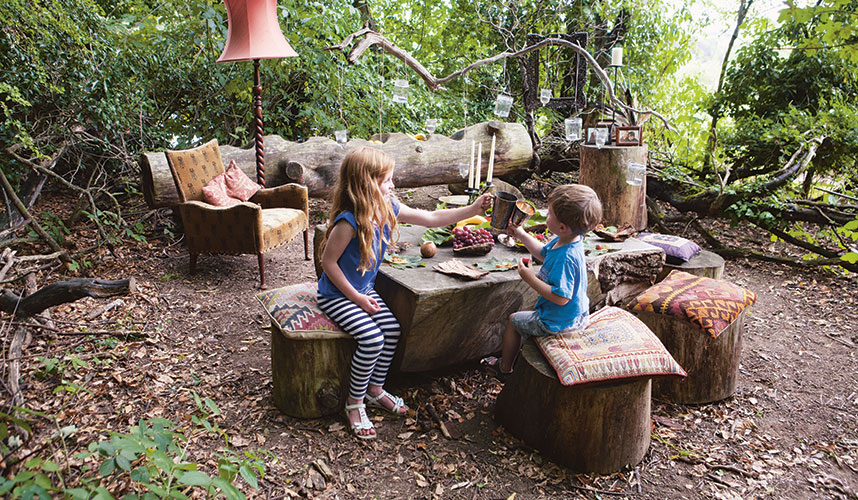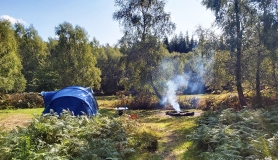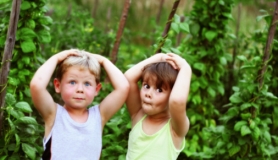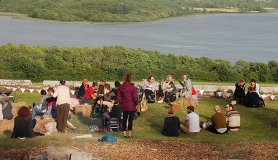Wild outdoor spaces offer endless opportunities for free play, fun and exploration. Help children learn vital new skills and find out how to judge risk. Making space in our children’s lives for wild time makes them happier, healthier and encourages communication.
An outdoor den might be a hideaway in a garden hedge, a stick fort in the woods, a leafy shelter for spying on wildlife or a little house nestling among the branches of a favourite tree. It may be a driftwood shelter at the beach, an old shed converted into a mud café, a living willow dome or a hobbit hole among ancient tree roots. Dens may lead you into other worlds or time, providing a portal into a parallel world where woodland warriors, forest fairies or dangerous dragons hide among the trees. Here’s how to get started.
Taking the indoors outdoors is a magical way to celebrate a birthday, a family party, a midsummer evening or to put on some outdoor theatre. Create a ‘room’ in the garden, at the park, in the woods or on a riverbank, adding indoor details to create some unexpected magic.
Wild outdoor room
This woodland glade, with its rustic table and log stools, is perfect for an outdoor dining hall for a summer banquet. These tips will help you make your own wild outdoor room.
- Choose a defined space in the woods, the park or the garden; the space should be room-sized, and although it doesn’t need to be totally enclosed, it should be clearly defined by trees, bushes or a pile of sticks.
- This woodland clearing becomes a room as soon as it is furnished with a standard lamp, an armchair and colourful cushions on log stools. But extra details such as candlesticks, family photos, a picture frame and a vase on a log side table make it feel like home.
- The log table has natural details of leaf place mats, bark plates and a huge bark fruit bowl, lined with giant leaves.
- After dark, the room will be lit by a wild chandelier. This is made by hanging night-lights in jars and glass candle holders from a long stick that is suspended by rope across the gap between two trees. The jars have string or wire tied around the top so they can be easily attached.
- Choose indoor things that fit with whatever magical setting you are trying to create; perhaps an old deep-pile rug, or strings of leaf bunting and pictures hanging from the trees.
- Enjoy your outdoor party! And don’t forget to take all the indoor things back inside when the party is over.
Be prepared
So, you are off to the woods, the garden or the adventure playground to make a den. What will you need?
• Wear comfy old clothes. If it’s wet outside or you are going somewhere a bit overgrown, wear waterproof outerwear or dungarees.
•Thick gardening gloves in case of prickles or stings.
• Stuff for tying and fixing things together.
• Things to use as a roof and to cover the ground.
• Enough den rations to feed and water the den-building workers or to prepare a mini-feast to enjoy in your completed den.
DEN BUILDING TIPS FOR KIDS
What are the key ingredients for making great dens? We think you need lots of imagination, a good location, some building materials and friends to work with. Our Going Wild top den tips will help you build sturdy shelters, have fun and stay safe.
- Only make dens in safe places. Don’t make them under dead trees, too near water, beside a busy road… you get the picture.
- Make sure a grownup knows where you are and what you are doing.
- Build carefully; do you really want your den to collapse on top of you?
- Choose den-building materials that are strong and safe. It’s best not to use very heavy branches, rotten branches, thorny sticks or bunches of stinging nettles. If building a den from old junk, don’t use glass or wood with nails sticking out of it.
- Never leave litter behind. It’s OK to leave a natural den in place, but remember it may not be quite the same when you go back!
- Take care when using knives and homemade weapons, making fires or making dens near water.
- Always look after wild places wherever they are; don’t damage living trees and plants. Care for them so they will continue to be there to care for you in the future.
More inspiration
READ The Den Book by Fiona Danks and Jo Schofield, published by Frances Lincoln, £12.99







